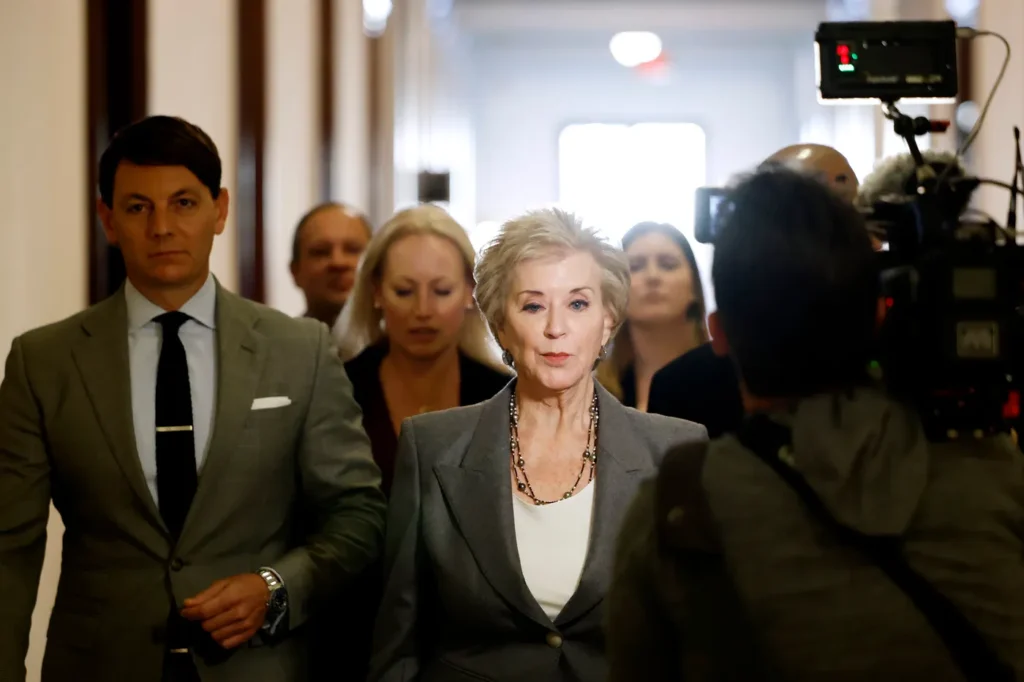The Trump Administration’s Crusade Against Federal Agencies
The Trump administration’s aggressive restructuring of federal agencies has dominated headlines, with targets like USAID and the Office of Personnel Management reshaped by executive orders and loyalist appointees. Yet its next goal—the U.S. Department of Education—faces unexpected roadblocks. Promised as a cornerstone of Trump’s “America First” agenda, abolishing this department is proving more complex than anticipated. Here’s why.
Why the Department of Education Is a Harder Target
Congressional Mandates Anchor Its Existence
Unlike agencies vulnerable to executive actions, many Department of Education programs are enshrined in laws passed by Congress. For example, the Individuals with Disabilities Education Act (IDEA), which guarantees special education services, can’t be erased without legislative repeal—a high bar in a divided Congress.Popular Programs Fuel Public Support
From Title I grants for low-income schools to student loan oversight, the department administers initiatives with broad bipartisan appeal. A 2024 Wall Street Journal poll found 61% of Americans oppose eliminating the agency, including two-thirds of Republicans.The Quiet Power of Special Education Advocacy
Parents, teachers, and disability rights groups form a formidable grassroots network. Cuts to federal special education funding could force states to divert resources, risking backlash in swing districts.
Trump’s Strategy: Executive Orders vs. Legislative Reality
Executive Actions: Trump has directed the department to combat “indoctrination” in schools and prioritize school choice, sidestepping Congress. Meanwhile, tech allies like Elon Musk have embedded teams to accelerate staffing changes.
Legislative Hurdles: GOP leaders plan to use budget reconciliation to defund the department. However, dismantling it entirely requires bipartisan support—unlikely given its popular mandates.
The Linda McMahon Factor
Trump’s pick to lead the department, former wrestling executive Linda McMahon, remains unconfirmed amid incomplete background checks. Without a confirmed leader, restructuring efforts lack direction.
Political Risks for Republicans
Swing District Vulnerabilities
Republican lawmakers in competitive districts may balk at supporting cuts to Title I or special education, fearing voter backlash.Medicaid Cuts Compound the Threat
Proposed slashes to Medicaid could strain schools relying on those funds for student health services, exacerbating opposition.The School Choice Dilemma
While Christian nationalists and MAGA activists champion privatizing education, suburban voters—and even some Republicans—favor public school investments.
U.S. Department of Education: Its Role, Impact, and Future in a Changing Landscape
The U.S. Department of Education (often abbreviated as the DOE or Dept of Education) plays a central role in shaping the nation’s education policies, distributing federal funds, and administering programs that affect millions of students across the country. In recent years, the department has come under renewed scrutiny, particularly during the Trump administration, which proposed significant changes—including calls to reform or even abolish the agency. In this comprehensive blog, we’ll explore what the Department of Education does, examine its impact on education and student loans, and discuss the potential consequences if it were to be abolished. We will also highlight key resources and official links for further reading.
What Is the U.S. Department of Education?
Established in 1980, the U.S. Department of Education is a Cabinet-level agency charged with establishing policies, administering programs, and distributing funds to improve the quality of education in the United States. Its mission is to promote student achievement and preparation for global competitiveness by fostering educational excellence and ensuring equal access. The department oversees public education at all levels—from elementary and secondary schools to postsecondary institutions—and plays a pivotal role in addressing educational disparities and promoting equity.
For the official mission statement and comprehensive information, visit the U.S. Department of Education website
.
Core Functions and Responsibilities
The Department of Education carries out several key functions:
1. Policy Development and Administration
The department sets federal education policies and ensures that states, school districts, and higher education institutions comply with federal laws. This includes implementing legislation such as the Every Student Succeeds Act (ESSA) and managing federal initiatives designed to close achievement gaps.
2. Funding and Grants
One of the department’s primary responsibilities is to distribute billions of dollars in federal funding and grants to support schools and educational programs nationwide. These funds help improve educational infrastructure, support innovative teaching methods, and provide financial assistance to disadvantaged students.
3. Student Financial Aid and Loans
The DOE manages a range of student financial aid programs, including federal student loans and grants. Programs such as Pell Grants, Federal Direct Loans, and work-study opportunities are crucial for making higher education accessible and affordable for millions of students.
4. Data Collection and Reporting
Through initiatives like the National Center for Education Statistics (NCES), the department collects and analyzes data to assess the performance of educational systems across the country. This data helps inform policy decisions and drive improvements in educational outcomes.
5. Oversight and Accountability
The department monitors how federal funds are spent and ensures that educational institutions are held accountable for meeting standards. This includes audits, performance reviews, and enforcing compliance with federal regulations.
For more in-depth explanations of these functions, you can refer to educational research from sources such as the U.S. Government Accountability Office and policy analyses on sites like EdWeek.
The Department of Education Under Trump
During the Trump administration, the U.S. Department of Education came under significant political scrutiny and faced calls for major reforms. Critics, including prominent political figures and education advocates, argued that the department was inefficient, overly bureaucratic, and misaligned with a vision of “America First” education policies. Some proposals even suggested abolishing the department altogether, asserting that doing so would decentralize educational control to the states and local districts.
Key Controversies
- Policy Shifts: The Trump administration pushed for a reduction in federal oversight and an increase in state and local control over education. Proponents claimed this would lead to more tailored and effective educational strategies.
- Budget and Funding Reforms: There were calls to cut federal spending on education, arguing that funds could be better allocated or even privatized to foster innovation and competition.
- Abolition Proposals: Some conservative voices, including political figures aligned with Trump’s agenda, went as far as to question the need for a centralized Department of Education, arguing that its functions could be absorbed by other federal agencies or devolved to state governments.
For a detailed look at these debates, you might read analyses from Reuters and The Washington Post on how the Trump administration sought to reshape the education landscape .
What Would Happen If the Department Were Abolished?
Abolishing the Department of Education is a topic of intense debate. Proponents argue that removing a centralized federal agency could reduce bureaucracy, return control to state and local governments, and foster more innovative educational practices. However, opponents caution that such a move could lead to significant downsides:
Potential Benefits
- Decentralized Control: Abolition could empower states and local districts to tailor education policies to their specific needs, potentially leading to more responsive and effective educational systems.
- Reduced Bureaucracy: Eliminating the department might reduce the layers of bureaucracy and associated administrative costs, allowing more direct allocation of funds to schools.
Potential Risks
- Inconsistent Standards: Without a federal agency to enforce national education standards, disparities between states could widen, leading to unequal educational opportunities across the country.
- Funding Uncertainty: The central role of the DOE in distributing federal funding and grants might be lost, which could disrupt financial aid programs and federal investments in education.
- Loss of Data and Accountability: The DOE’s functions in data collection and reporting are crucial for tracking educational outcomes. Abolishing the department could result in a loss of coordinated data and accountability measures.
The debate over abolishing the DOE highlights the tension between federal oversight and local control—a recurring theme in U.S. education policy discussions. For further exploration, refer to opinion pieces and legislative analyses available on platforms such as EdWeek and Politico.
Student Loans and Financial Aid
One of the most critical functions of the Department of Education is administering student financial aid, including federal student loans and grants. These programs are designed to make higher education accessible to all Americans, regardless of economic background.
Key Programs
- Federal Direct Loans: The primary program for providing low-cost, flexible repayment student loans to millions of students.
- Pell Grants: Need-based grants that do not have to be repaid, aimed at supporting low-income students.
- Income-Driven Repayment Plans: Flexible repayment options that adjust monthly payments based on the borrower’s income and family size.
- Other Financial Assistance: Additional programs, including work-study opportunities and state-specific aid, also fall under the DOE’s purview.
The DOE’s management of these programs is critical for millions of students, and any changes to its structure or funding could have a profound impact on the higher education landscape in the United States.
For the latest information on student financial aid and loan programs, the Federal Student Aid website is an essential resource.
Key Resources and Further Reading
Here are some important links and resources for anyone looking to learn more about the U.S. Department of Education:
- U.S. Department of Education Official Website: ed.gov
- Federal Student Aid: studentaid.gov
- USA.gov – Department of Education: usa.gov/department-of-education
- EdWeek: edweek.org
- Politico Education Section: politico.com/education
- Reuters Education Coverage: reuters.com/education
These resources offer up-to-date news, policy analysis, and official documentation on the workings of the DOE and its programs.
Conclusion
The U.S. Department of Education remains a central player in shaping the educational landscape of the United States. Its responsibilities—from setting national policies and distributing billions in funding to managing student loans and financial aid—impact millions of lives every day. While proposals to reform or even abolish the department have sparked vigorous debate, the consequences of such drastic changes could reshape the fabric of American education.
As the political environment evolves and discussions about federal versus state control intensify, the future of the DOE will likely remain a hot topic. Whether you are a student navigating financial aid, a parent concerned about educational quality, or a policy enthusiast, staying informed about the Department of Education is essential.





